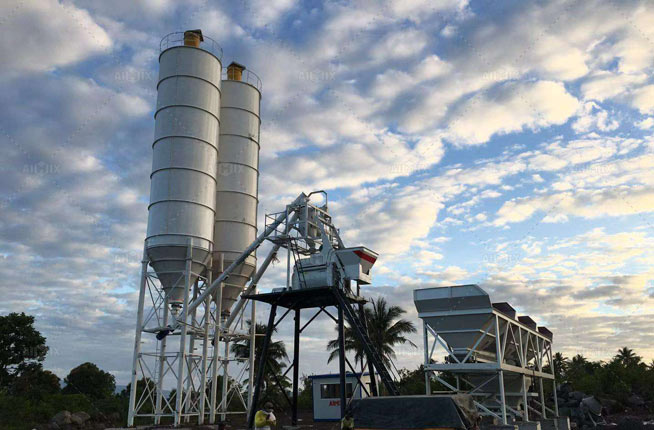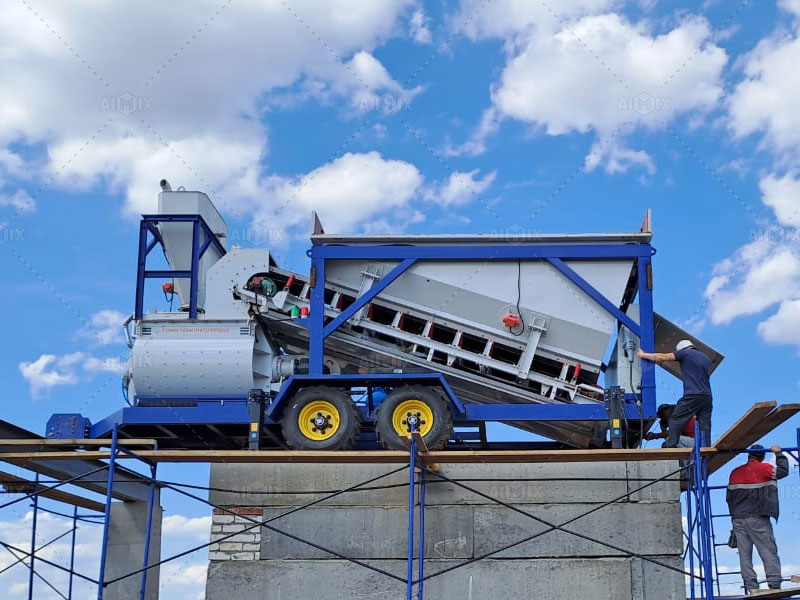As construction demands grow, companies face a key decision: should they invest in a self-built concrete mixing plant or continue buying from commercial suppliers? While purchasing ready mix concrete offers convenience, setting up a concrete plant can provide long-term savings and control. In this article, we conduct a cost comparison analysis between self-built concrete plants—including small concrete plant setups—and commercially purchased concrete to help contractors and developers make the right choice for their projects.
Initial Investment vs. Unit Cost
Concrete Plant Setup Costs
The most significant barrier to building your own concrete mixing plant is the initial capital required. Depending on the size and configuration, the concrete plant price(planta de hormigón precio) can vary widely. A small concrete plant with 25–35 m³/h output may cost between $30,000 to $60,000, while a mid-range batching plant (60–90 m³/h) can exceed $100,000 when including silos, conveyors, and automation systems.
Commercial Concrete Purchase Cost
Buying commercial concrete from a ready mix concrete plant usually costs between $100 and $150 per cubic meter, depending on location, transportation distance, and mix specifications. While there’s no upfront investment, the per-unit cost accumulates quickly over large volumes.
Break-Even Volume
If your project requires over 10,000 m³ of concrete, the cumulative purchase cost may exceed the investment needed to build a small-to-medium concrete mixing plant. Many contractors find that break-even is reached within 6 to 12 months of continuous operation.

Operational and Logistic Factors
Transportation and Delivery Delays
One of the main challenges when relying on commercial suppliers is transportation logistics. Delays due to traffic or scheduling conflicts can disrupt the pouring schedule, leading to labor inefficiencies and wasted time on site. Having an on-site or nearby concrete mixing plant(planta hormigonera) eliminates these delays.
Material Control and Consistency
Producing concrete in-house ensures better quality control, especially when using advanced batching software. Commercial concrete may sometimes suffer from variable slump, setting time, or contamination during transport. A self-built ready mix concrete plant provides real-time adjustments to maintain consistency across batches.
Flexibility in Mix Design
With your own plant, you can modify the mix design at any time—such as adjusting the water-cement ratio or adding specific admixtures. This is particularly useful in projects requiring different concrete grades or using recycled materials. Commercial suppliers often charge extra for non-standard mixes.
Long-Term Financial Benefits
Lower Cost per Cubic Meter
After recovering the initial concrete plant price, the in-house cost per cubic meter drops significantly. For a small concrete plant, production cost can be as low as $40–$60 per m³, including raw materials, labor, fuel, and maintenance. Compared to buying at $120/m³, the savings are substantial for ongoing operations.
Additional Revenue Streams
If your plant capacity exceeds your own needs, selling excess concrete to nearby contractors can generate extra income. In regions with limited access to commercial suppliers, this strategy often turns a plant into a profit center instead of just a cost-saving measure.
Depreciation and Asset Value
A concrete plant is a tangible asset that holds resale value. Even after several years of use, a well-maintained concrete mixing plant can be sold or relocated for new projects. This capital recovery potential adds value over simply purchasing consumable concrete.
When Buying Commercial Concrete Makes More Sense
Short-Term or Low-Volume Projects
For projects lasting less than 3–6 months or requiring fewer than 3,000–5,000 m³ of concrete, setting up a concrete plant may not be cost-effective. In such cases, the convenience of ordering from a ready mix concrete plant(planta de hormigon elaborado) outweighs the benefits of ownership.
Urban Projects with Space Constraints
In densely populated areas where space is limited, there may not be room for plant installation. Transporting concrete from a nearby supplier becomes more practical, especially when traffic conditions are predictable and delivery schedules are reliable.
Access to Reliable Suppliers
If local commercial suppliers consistently deliver high-quality concrete on time and at competitive prices, there may be little incentive to build your own plant. However, it’s crucial to assess long-term pricing trends and potential for cost escalation over time.

Choosing the Right Plant for Your Needs
Small Concrete Plant for Flexibility
Many contractors choose to start with a small concrete plant(planta de concreto pequeña) for pilot projects or remote jobsites. These compact models are easier to install and operate and provide just enough capacity to meet medium-scale demand without overinvestment.
Customized Ready Mix Concrete Plant Setup
Larger developers or companies with multiple projects may benefit from a full-sized ready mix concrete plant with automation features, multiple aggregate bins, and bulk cement silos. These systems support higher throughput and better integration with central management platforms.
Portable and Modular Configurations
Portable plants can be relocated between jobsites, reducing transport costs and maximizing usage. Modular designs also allow for gradual expansion of plant capacity, aligning investment with project growth.
Conclusion
When evaluating whether to purchase commercial concrete or build your own concrete mixing plant, consider both the short-term and long-term financial impacts. A self-built small concrete plant can dramatically lower your cost per cubic meter and offer greater control over production, especially in large-scale or ongoing projects. Meanwhile, commercial ready mix concrete plant services offer convenience and flexibility for short-term or low-volume needs. The best decision depends on your specific project scope, budget, and logistical conditions—but with clear volume thresholds and cost analysis, the numbers often speak for themselves.